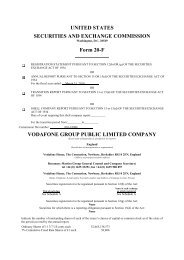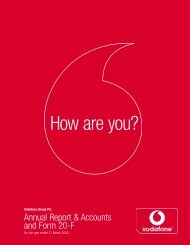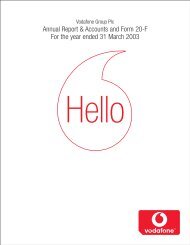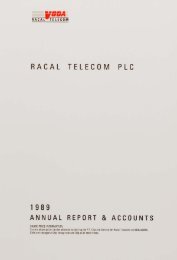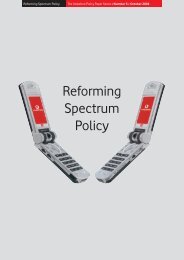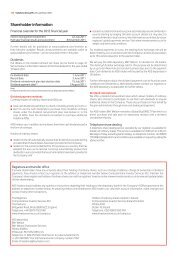The way ahead? - Vodafone
The way ahead? - Vodafone
The way ahead? - Vodafone
You also want an ePaper? Increase the reach of your titles
YUMPU automatically turns print PDFs into web optimized ePapers that Google loves.
86<br />
<strong>Vodafone</strong> Group Plc<br />
Annual Report 2013<br />
Critical accounting estimates<br />
<strong>The</strong> Group prepares its consolidated financial statements in accordance<br />
with IFRS as issued by the IASB and IFRS as adopted by the EU,<br />
the application of which often requires judgements to be made by<br />
management when formulating the Group’s financial position and<br />
results. Under IFRS, the directors are required to adopt those accounting<br />
policies most appropriate to the Group’s circumstances for the purpose<br />
of presenting fairly the Group’s financial position, financial performance<br />
and cash flows.<br />
In determining and applying accounting policies, judgement is often<br />
required in respect of items where the choice of specific policy,<br />
accounting estimate or assumption to be followed could materially<br />
affect the reported results or net asset position of the Group; it may later<br />
be determined that a different choice would have been more appropriate.<br />
Management considers that certain accounting estimates and<br />
assumptions relating to revenue, taxation, business combinations,<br />
intangible assets (goodwill and finite lived assets), property, plant and<br />
equipment, provisions and contingent liabilities, and impairment are its<br />
critical accounting estimates.<br />
A discussion of these critical accounting estimates is provided<br />
below and should be read in conjunction with the disclosure of the<br />
Group’s significant IFRS accounting policies provided in note A2 to the<br />
consolidated financial statements.<br />
Management has discussed its critical accounting estimates and<br />
associated disclosures with the Company’s Audit and Risk Committee.<br />
Revenue recognition<br />
Arrangements with multiple deliverables<br />
In revenue arrangements including more than one deliverable,<br />
the deliverables are assigned to one or more separate units<br />
of accounting and the arrangement consideration is allocated to each<br />
unit of accounting based on its relative fair value.<br />
Determining the fair value of each deliverable can require complex<br />
estimates due to the nature of the goods and services provided.<br />
<strong>The</strong> Group generally determines the fair value of individual elements<br />
based on prices at which the deliverable is regularly sold on a standalone<br />
basis after considering volume discounts where appropriate.<br />
Gross versus net presentation<br />
When deciding the most appropriate basis for presenting revenue<br />
or costs of revenue, both the legal form and substance of the agreement<br />
between the Group and its business partners are reviewed to determine<br />
each party’s respective role in the transaction.<br />
Where the Group’s role in a transaction is that of principal, revenue<br />
is recognised on a gross basis. This requires revenue to comprise<br />
the gross value of the transaction billed to the customer, after trade<br />
discounts, with any related expenditure charged as an operating cost.<br />
Where the Group’s role in a transaction is that of an agent, revenue<br />
is recognised on a net basis with revenue representing the margin earned.<br />
Taxation<br />
<strong>The</strong> Group’s tax charge on ordinary activities is the sum of the total current<br />
and deferred tax charges. <strong>The</strong> calculation of the Group’s total tax charge<br />
necessarily involves a degree of estimation and judgement in respect<br />
of certain items whose tax treatment cannot be finally determined<br />
until resolution has been reached with the relevant tax authority or,<br />
as appropriate, through a formal legal process. <strong>The</strong> final resolution of some<br />
of these items may give rise to material profits, losses and/or cash flows.<br />
<strong>The</strong> complexity of the Group’s structure makes the degree of estimation<br />
and judgement more challenging. <strong>The</strong> resolution of issues is not<br />
al<strong>way</strong>s within the control of the Group and it is often dependent on the<br />
efficiency of the legal processes in the relevant taxing jurisdictions<br />
in which the Group operates. Issues can, and often do, take many years<br />
to resolve. Payments in respect of tax liabilities for an accounting period<br />
are made by payments on account and on the final resolution of open<br />
items. As a result there can be substantial differences between the tax<br />
charge in the consolidated income statement and tax payments.<br />
Recognition of deferred tax assets<br />
<strong>The</strong> recognition of deferred tax assets is based upon whether it is more<br />
likely than not that sufficient and suitable taxable profits will be available<br />
in the future against which the reversal of temporary differences can<br />
be deducted. To determine the future taxable profits, reference is made<br />
to the latest available profit forecasts. Where the temporary differences<br />
are related to losses, relevant tax law is considered to determine the<br />
availability of the losses to offset against the future taxable profits.<br />
Significant items on which the Group has exercised accounting<br />
judgement include recognition of deferred tax assets in respect of losses<br />
in Germany and Luxembourg and the recognition of a deferred tax asset<br />
in respect of capital allowances in the United Kingdom. <strong>The</strong> amounts<br />
recognised in the consolidated financial statements in respect of each<br />
matter are derived from the Group’s best estimation and judgement<br />
as described above. See note 7 to the consolidated financial statements.<br />
Recognition therefore involves judgement regarding the future financial<br />
performance of the particular legal entity or tax group in which the<br />
deferred tax asset has been recognised.<br />
Historical differences between forecast and actual taxable profits have not<br />
resulted in material adjustments to the recognition of deferred tax assets.<br />
Business combinations<br />
<strong>The</strong> recognition of business combinations requires the excess of the<br />
purchase price of acquisitions over the net book value of assets acquired<br />
to be allocated to the assets and liabilities of the acquired entity.<br />
<strong>The</strong> Group makes judgements and estimates in relation to the fair value<br />
allocation of the purchase price. If any unallocated portion is positive<br />
it is recognised as goodwill and if negative, it is recognised in the<br />
income statement.<br />
Goodwill<br />
<strong>The</strong> amount of goodwill initially recognised as a result of a business<br />
combination is dependent on the allocation of the purchase price to the<br />
fair value of the identifiable assets acquired and the liabilities assumed.<br />
<strong>The</strong> determination of the fair value of the assets and liabilities is based,<br />
to a considerable extent, on management’s judgement.<br />
Allocation of the purchase price affects the results of the Group as finite<br />
lived intangible assets are amortised, whereas indefinite lived intangible<br />
assets, including goodwill, are not amortised and could result in differing<br />
amortisation charges based on the allocation to indefinite lived and<br />
finite lived intangible assets.<br />
On transition to IFRS the Group elected not to apply IFRS 3, “Business<br />
combinations”, retrospectively as the difficulty in applying these<br />
requirements to the large number of business combinations completed<br />
by the Group from incorporation through to 1 April 2004 exceeded<br />
any potential benefits. Goodwill arising before the date of transition<br />
to IFRS, after adjusting for items including the impact of proportionate<br />
consolidation of joint ventures, amounted to £78,753 million.<br />
If the Group had elected to apply the accounting for business<br />
combinations retrospectively it may have led to an increase or decrease<br />
in goodwill and increase in licences, customer bases, brands and related<br />
deferred tax liabilities recognised on acquisition.<br />
Finite lived intangible assets<br />
Other intangible assets include the Group’s aggregate amounts spent<br />
on the acquisition of licences and spectrum, computer software,<br />
customer bases, brands and development costs. <strong>The</strong>se assets<br />
arise from both separate purchases and from acquisition as part<br />
of business combinations.<br />
On the acquisition of mobile network operators the identifiable<br />
intangible assets may include licences, customer bases and brands.<br />
<strong>The</strong> fair value of these assets is determined by discounting estimated<br />
future net cash flows generated by the asset where no active market for<br />
the assets exists. <strong>The</strong> use of different assumptions for the expectations<br />
of future cash flows and the discount rate would change the valuation<br />
of the intangible assets.



